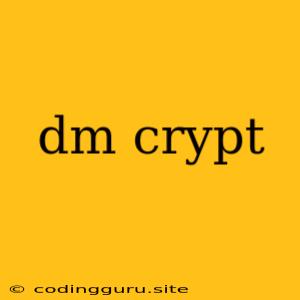Demystifying dm-crypt: Encryption for Your Linux Disks
dm-crypt is a powerful encryption tool built into the Linux kernel, providing a robust and secure way to protect your data at rest. This article delves into the intricacies of dm-crypt, explaining its purpose, functionality, and how you can utilize it to enhance your system's security.
Why Encrypt Your Disks?
In today's digital landscape, data security is paramount. Encryption adds a crucial layer of protection by transforming your data into an unreadable format, rendering it inaccessible to unauthorized individuals. By encrypting your disks, you safeguard your sensitive information from theft, unauthorized access, and potential breaches.
What is dm-crypt?
dm-crypt is a Linux kernel module that provides full disk encryption (FDE). It operates as a transparent encryption layer, handling the encryption and decryption processes without requiring user intervention. Essentially, dm-crypt acts as a virtual disk, intercepting all read and write operations and encrypting or decrypting the data accordingly.
How does dm-crypt work?
dm-crypt utilizes a combination of encryption algorithms and cryptographic keys to secure your data. Here's a simplified overview of the process:
- Key Generation: A unique encryption key is generated and stored securely.
- Encryption: When data is written to the disk, dm-crypt encrypts it using the key before storing it.
- Decryption: When data is read from the disk, dm-crypt decrypts it using the key, providing you with the original information.
Using dm-crypt: A Step-by-Step Guide
Implementing dm-crypt might seem daunting at first, but with the right tools and guidance, it's a straightforward process.
Step 1: Choose your encryption algorithm
dm-crypt offers support for various encryption algorithms, including:
- AES-XTS: Widely considered a strong and efficient choice.
- AES-CBC: A common and reliable algorithm.
- Serpent: A robust algorithm with a high security margin.
- Twofish: Another reliable algorithm with strong security properties.
Step 2: Generate your encryption key
You can create an encryption key using tools like cryptsetup, openssl, or gpg. It's crucial to store this key securely, as it's the only way to access your encrypted data.
Step 3: Set up your dm-crypt volume
The cryptsetup tool is commonly used for managing dm-crypt volumes. It allows you to encrypt your entire hard drive or specific partitions.
Step 4: Mounting the encrypted volume
Once your volume is encrypted, you need to mount it to access your files. This involves providing the correct encryption key to decrypt the data.
Step 5: Secure your key
Store your encryption key securely. You can choose from several options, such as:
- Password-based key derivation: Enter your password to unlock your data.
- Hardware-based key storage: Utilize a dedicated hardware security module (HSM) for enhanced security.
- Key files: Store your key in a secure file.
Tips for Optimal Security
- Use a strong passphrase: Choose a long and complex passphrase to ensure strong key protection.
- Don't store your key on the encrypted disk: Keep your key separate from your data.
- Regularly update your system: Maintain up-to-date security patches for optimal protection.
- Use a reputable encryption algorithm: Opt for well-established algorithms like AES-XTS or Serpent.
Conclusion
dm-crypt provides a powerful and effective method to safeguard your data on Linux systems. By encrypting your disks, you add a crucial layer of protection, ensuring your privacy and security. While setting up dm-crypt might require some technical expertise, the benefits in terms of data protection are undeniable. Remember to choose a strong encryption algorithm, store your key securely, and follow best practices for maximum security.
